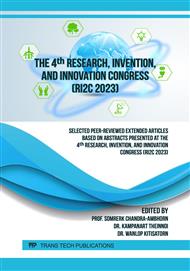[1]
Xia, Xiaodong, et al. "Revealing the AC electromechanically coupled effects and stable sensitivity on the dielectric loss in CNT-based nanocomposite sensors." Materials & Design 216 (2022): 110557.
DOI: 10.1016/j.matdes.2022.110557
Google Scholar
[2]
Melvin, Gan Jet Hong, Qing-Qing Ni, and Toshiaki Natsuki. "Fabrication and characterization of polymer-based electroactive nanocomposite actuator." Microelectronic engineering 126 (2014): 9-12.
DOI: 10.1016/j.mee.2014.04.001
Google Scholar
[3]
Parameswaranpillai, Jyotishkumar, and Sayan Ganguly. "Introduction to polymer composite-based sensors." Polymeric Nanocomposite Materials for Sensor Applications. Woodhead Publishing, 2023. 1-21.
DOI: 10.1016/b978-0-323-98830-8.00006-0
Google Scholar
[4]
Lu, Yang, et al. "Recent developments in via advanced polymer nanocomposite-based wearable strain sensors." Biosensors and bioelectronics 123 (2019): 167-177.
DOI: 10.1016/j.bios.2018.08.037
Google Scholar
[5]
Reddy, S.K., et al. "Strain and damage-sensing performance of biocompatible smart CNT/UHMWPE nanocomposites." Materials Science and Engineering: C 92 (2018): 957-968.
DOI: 10.1016/j.msec.2018.07.029
Google Scholar
[6]
Lim, Hanpin, and Stephen W. Hoag. "Plasticizer effects on physical–mechanical properties of solvent cast Soluplus® films." Aaps Pharmscitech 14 (2013): 903-910.
DOI: 10.1208/s12249-013-9971-z
Google Scholar
[7]
ASTM Standards D638 – 22. Standard Test Method forTensile Properties of Plastics.
Google Scholar
[8]
Sherif, Hany A., and Fahad A. Almufadi. "Fabrication and characterization of silicone rubber/multiwalled carbon nanotubes nanocomposite sensors under impact force." Sensors and Actuators A: Physical 297 (2019): 111479.
DOI: 10.1016/j.sna.2019.07.004
Google Scholar
[9]
Liu, Lili, Zhiqiang Niu, and Jun Chen. "Flexible supercapacitors based on carbon nanotubes." Chinese Chemical Letters 29.4 (2018): 571-581.
DOI: 10.1016/j.cclet.2018.01.013
Google Scholar
[10]
ASTM Standards F648 – 21. Standard Specification for Ultra-High-Molecular-Weight Polyethylene Powder and Fabricated Form for Surgical Implants
DOI: 10.1520/f0648-96
Google Scholar
[11]
Gupta, Tejendra K., and Shanmugam Kumar. "Fabrication of carbon nanotube/polymer nanocomposites." Carbon Nanotube-Reinforced Polymers. Elsevier, 2018. 61-81.
DOI: 10.1016/b978-0-323-48221-9.00004-2
Google Scholar
[12]
Wang, Enliang, et al. "Effect of graphene oxide-carbon nanotube hybrid filler on the mechanical property and thermal response speed of shape memory epoxy composites." Composites Science and Technology 169 (2019): 209-216.
DOI: 10.1016/j.compscitech.2018.11.022
Google Scholar
[13]
Reddy, S. K., et al. "Strain and damage-sensing performance of biocompatible smart CNT/UHMWPE nanocomposites." Materials Science and Engineering: C 92 (2018): 957-968.
DOI: 10.1016/j.msec.2018.07.029
Google Scholar
[14]
Kumar, R. Manoj, et al. "Effects of carbon nanotube aspect ratio on strengthening and tribological behavior of ultra high molecular weight polyethylene composite." Composites Part A: Applied Science and Manufacturing 76 (2015): 62-72.
DOI: 10.1016/j.compositesa.2015.05.007
Google Scholar
[15]
Alam, M. K., et al. "Structural, mechanical, thermal, and electrical properties of carbon black reinforced polyester resin composites." Journal of Applied Polymer Science 131.13 (2014).
DOI: 10.1002/app.40421
Google Scholar
[16]
Alam, Fahad, et al. "Electrical, mechanical and thermal properties of graphene nanoplatelets reinforced UHMWPE nanocomposites." Materials Science and Engineering: B241(2019):82-91.
DOI: 10.1016/j.mseb.2019.02.011
Google Scholar
[17]
Deplancke, Tiana, et al. "Impact of carbon nanotube prelocalization on the ultra-low electrical percolation threshold and on the mechanical behavior of sintered UHMWPE-based nanocomposites." Polymer 111 (2017): 204-213.
DOI: 10.1016/j.polymer.2017.01.040
Google Scholar
[18]
Mierczynska, A., et al. "Electrical and mechanical properties of carbon nanotube/ultrahigh‐molecular‐weight polyethylene composites prepared by a filler prelocalization method." Journal of applied polymer science 105.1 (2007): 158-168.
DOI: 10.1002/app.26044
Google Scholar
[19]
Singh, Karamvir, et al. "Fabrication of serpentine and I structured graphene-CNT based highly sensitive and flexible strain sensors." Microelectronic Engineering 250 (2021): 111631.
DOI: 10.1016/j.mee.2021.111631
Google Scholar
[20]
He, Yuxin, et al. "CNT/PDMS conductive foam-based piezoresistive sensors with low detection limits, excellent durability, and multifunctional sensing capability." Sensors and Actuators A: Physical 358 (2023): 114408.
DOI: 10.1016/j.sna.2023.114408
Google Scholar
[21]
Amjadi, Morteza, and Metin Sitti. "Self‐Sensing Paper Actuators Based on Graphite–Carbon Nanotube Hybrid Films." Advanced science 5.7 (2018): 1800239.
DOI: 10.1002/advs.201800239
Google Scholar
[22]
Nag, A., et al. "3D printed mould-based graphite/PDMS sensor for low-force applications." Sensors and Actuators A: Physical 280 (2018): 525-534.
DOI: 10.1016/j.sna.2018.08.028
Google Scholar
[23]
Nag, Anindya, et al. "Strain induced graphite/PDMS sensors for biomedical applications." Sensors and Actuators A: Physical 271 (2018): 257-269.
DOI: 10.1016/j.sna.2018.01.044
Google Scholar
[24]
Alarifi, Ibrahim M. "Investigation the conductivity of carbon fiber composites focusing on measurement techniques under dynamic and static loads." Journal of Materials Research and Technology 8.5 (2019): 4863-4893.
DOI: 10.1016/j.jmrt.2019.08.019
Google Scholar



